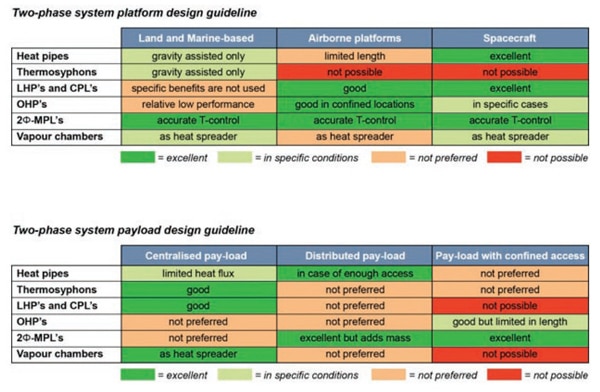Authors
Johannes van Es and Henk Jan van Gerner, National Aerospace Laboratory NLR, The Netherlands
The next generation military platforms will be equipped with more and more powerful sensors and avionics. The increasing power densities in electronic subsystems demand more cooling power while survivability requirements limit the possibilities for extending or adding cooling systems. This trend inevitably leads to thermal challenges which need to be solved. There are two main approaches for solving these problems. The first aims to increase the cooling capacity of the system. It is most practical for new platforms. The second approach, more suitable for upgrades of existing platforms, is to optimize the systems to enable them to fully exploit their existing capabilities. One of the focal points will be the reduction of the temperature drop between the dissipating electronics and the heat sink as illustrated in Figure 1.
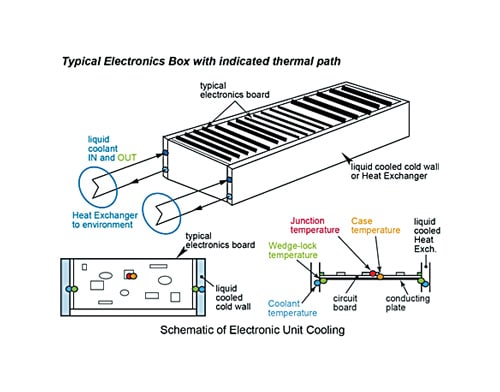
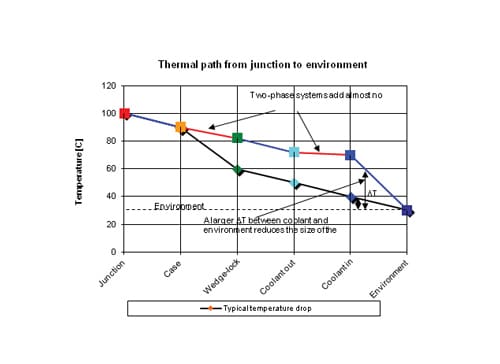
In this article, an overview of the different types of two-phase cooling systems is given, including the main advantages and drawbacks, and examples of their use.
Heat Pipes
The most well-known two-phase heat transport system is the heat pipe [2]. A heat pipe is a closed pipe filled with vapor and liquid of a dedicated working fluid. On the walls of the heat pipe a capillary structure is implemented (axial grooves and/or a capillary wick) and therefore contains the liquid in the pipe.

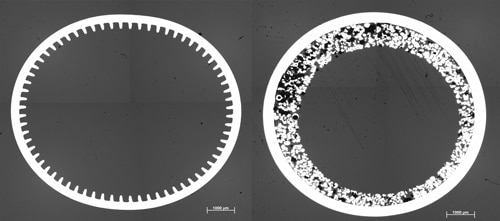
On one end of the heat pipe dissipating electronics are attached. The dissipated heat evaporates the liquid, and absorbs the heat. By the creation of the additional vapor the vapor flows to the other side of the heat pipe where it condenses and subsequently rejects the heat. The liquid is pumped back by capillary action closing the loop. Because the evaporation and condensation “occurs” at the same temperature the temperature drop over the pipe is only a few degrees induced by the vapor pressure drop over the pipe. Heat pipes are widely used in terrestrial design (laptops, CPU-cooling) and spacecraft thermal design (heat pipe radiators). The main drawback of heat pipes is their poor performance when used against gravity.
Thermosyphons
A special type of heat pipe is the thermosyphon. A thermosyphon is a heat pipe which uses gravity to transport the liquid. The heat is therefore always collected and evaporated on the bottom side and condensed at the top side where the heat is removed by forced cooling or radiation. The liquid flows back to the bottom to close the loop. Thermosyphons are for example used in mountainous areas to keep roads or railways snow-free. The design is straightforward and robust, however even more dependent on orientation than a normal heat pipe.
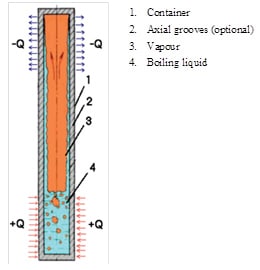
Vapor Chambers
A less common type of heat pipe is the vapor chamber. In fact it is a flat heat pipe with a very small length over diameter ratio. Vapor chambers are used to increase heat transfer of heat sinks, for example to enhance CPU- or power electronics cooling. Vapor chambers are gravity dependent but flat versions or types with the right wick design can be ruggedized to withstand acceleration forces. This type of heat pipes are mainly used as heat spreader but can also be used for accurate (mK-level) temperature control.
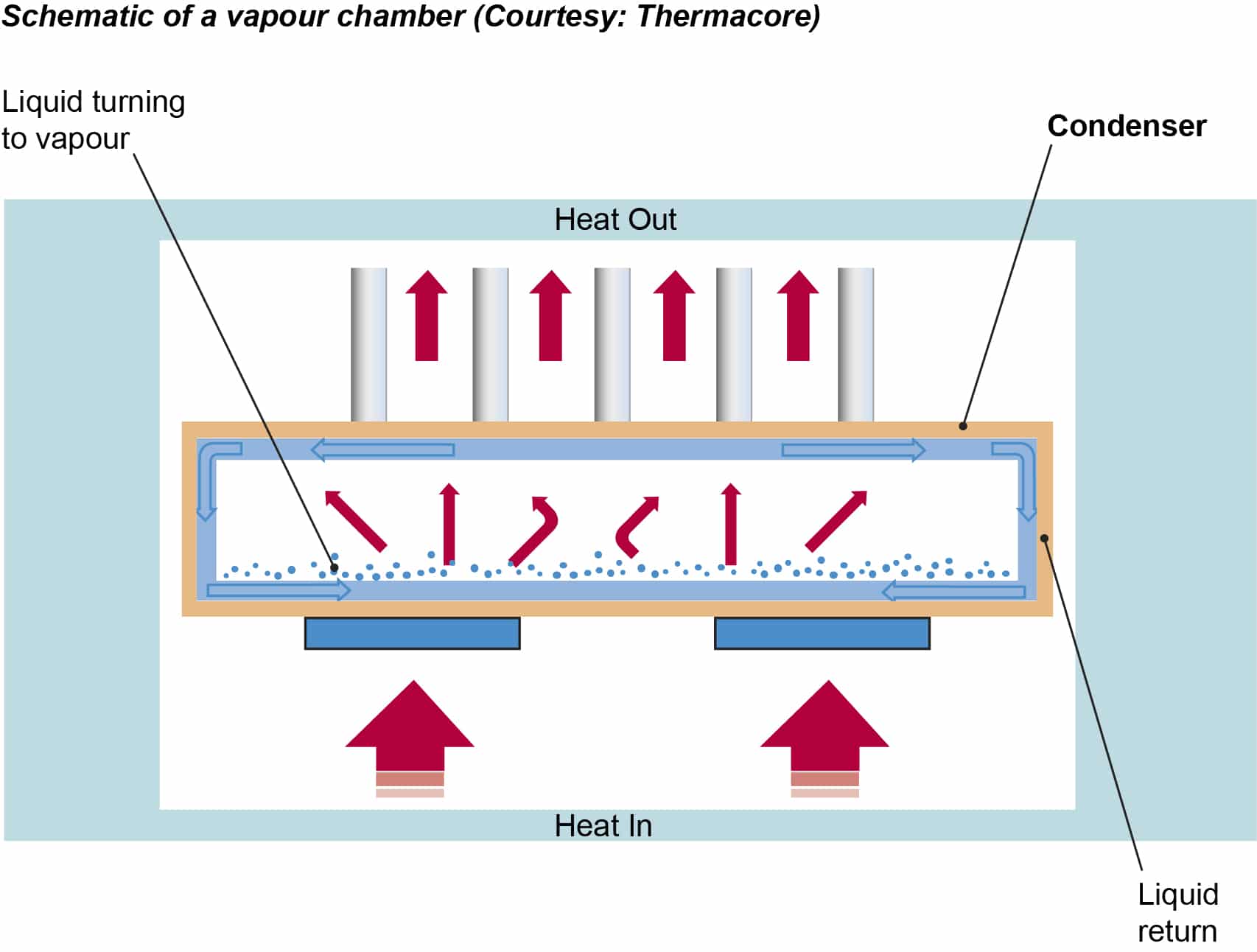
Loop Heat Pipes (LHP) and Capillary Pumped Loops (CPL)
The Loop Heat Pipe (LHP) and Capillary Pumped Loop (CPL) are more advanced types of heat pipes. These loops separate, concentrate and optimize the capillary pumping action in the evaporator section (See Figure 3).
Another drawback of LHP’s and CPL’s is the difficulty to extend them to multi-evaporator systems. Extensive research to multi-evaporator LHP’s has been performed [4] which resulted in improved designs but it did not lead yet to implementations.
Two-Phase Mechanically Pumped Loop (2F-MPL)
Instead of capillary pumping forces also a mechanical pump can be implemented in a two-phase loop. The schematic is shown in Figure 4. Main components are an accumulator, an evaporator and a condenser section, a heat exchanger (optional) and of course a pump. The accumulator is temperature- or pressure controlled and sets the evaporation temperature. Although the pump adds complexity and a lifetime issue this system has considerable advantages.

The system is very flexible, the heat sources and heat sink can be located anywhere in the system and the heat load can be transported over large distances. Furthermore, the temperature of the heat sources can be accurately controlled. Because of these advantages, a two-phase mechanically pumped loop was selected as the only feasible concept for the Tracker Thermal Control System (TTCS) of the AMS02 experiment [5], a development lead by NLR [6]. This system was launched with the space shuttle (STS-134, May 2011) and subsequently mounted on the International Space Station for a 15 year mission. The system provides <0.2˚C temperature stability for the payload in an environment with large temperature variations. Recent terrestrial test-setups even achieve <0.001˚C temperature stability with changing heat loads. 2F-MPL can be used to transport small (10 W) to very large (MW) heat loads. In view of the pump electronics mass 2F-MPL’s are most suitable for navy and land-based applications requiring accurate temperature control (e.g. active antennas). When smaller pumps with more compact electronics are developed 2F-MPL’s will also become attractive for air-based and satellite platforms.
Oscillating Heat Pipes (OHP)
A special two-phase system is the Oscillating Heat Pipe (OHP) [7-11].

Despite its name the OHP-principle is completely different from a heat pipe. An Oscillating Heat Pipe is a meandering tube with a diameter between 0.25 and 2 mm. As a result of capillary forces, the tube is filled with liquid and vapor plugs of a working fluid (see Figure 5). Heat is transported in the OHP by the oscillation of the plugs in the OHP. This oscillatory motion is driven by the generation and the expansion of vapor bubbles and the inertia of the plugs. Heat is transported from the hot to the cold side mainly by the sensible heat of the liquid, and the temperature drop along an OHP is approximately 10-15°C. This is a much larger temperature drop than for a classical heat pipe . An interesting feature of the OHP is that it can operate under high g-loads [10]. The NLR developed Flat Swinging Heat Pipe (FSHP) has been tested upto 8.4g without decrease in performance. Until now OHP’s are only implemented on a small scale e.g. for CPU cooling [12].
Advantages and drawbacks of two-phase heat transport systems
To elucidate where the above listed two-phase systems are best suited, first the disadvantages are discussed. Main general disadvantages of two-phase systems for use in military platforms are:
- Gravity dependence
- Inflexibility of the interface to the payload (evaporator)
The gravity dependence makes the use of general heat pipes and thermosyphons only possible in gravity assisted and zero-gravity environments and therefore unsuitable for air-based platforms. Some special heat pipe designs are available but the transport length is limited or in case of OHP’s the performance is much lower. LHP’s and CPL’s can withstand high-g forces and are therefore also suitable for aircraft applications. The inflexibility of payload interface is the second general drawback of two-phase heat transport systems. Evaporation sections of heat pipes themselves are flexible enough and are therefore implemented in an extensive amount of satellite, marine and ground-based designs. The concentrated LHP and CPL evaporator sections are however bulky and limited in length. Therefore sensors or other payloads with distributed elements are not easy to cover by one or two LHP evaporators. In satellite applications combined HP-LHP networks are successfully used to cope with this problem at the cost of extensive test campaigns. In aircraft design heat pipe networks are not feasible in view of the gravity problems, therefore only single LHP evaporators are used for concentrated payload sensors. For payload sensors with more distributed electronics the 2F-MPL’s are a feasible option as the evaporator can facilitate multiple widespread sensors with only small diameter (1-8 mm) tubing. The 2F-MPL’s bulky accumulator and pump section can be located far away from the payload. This makes 2F-MPL specifically suitable for implementation in existing payloads for platform upgrades.
Two-phase systems would not be so popular if there were no clear benefits. The most well-known advantage is the mass effectiveness. As the latent heat of most fluids is at least one or two orders larger than the sensible heat, a two-phase heat transport system can transport considerably more heat per fluid mass resulting in a lower system mass and smaller cooling tubes. This led to the extensive application of heat pipes and loop heat pipes in spacecraft and aircraft design as in these platforms mass is a driving requirement.
The second clear but less well-known advantage is the high temperature stability of two-phase heat transport systems. As two-phase systems make use of evaporation (boiling) of a liquid and boiling always happens at one temperature, two-phase systems can perfectly control delicate payloads on a stable temperature (e.g. active antennas and radar applications).
Rough Two-Phase Design Guideline
In the two tables below rough guidelines for system engineers are given to identify which type of two-phase heat transport system would fit best for their type of platform and payload. In the tables below the applicability of the types of two-phase systems for the different platforms is summarized. The main selection driver in the first table is the gravity dependence.
In the second table a rough division in payloads is made based on their lay-out of heat sources. A centralized payload is a payload with a concentrated heat source like a linear motor. A distributed payload has a large number of widespread heat sources like active antennas or SAR radar applications. Finally a third type of payload is defined with confined access.
Conclusions
An overview is given of two-phase heat transport systems with benefits and drawbacks of the systems. Rough design guidelines are given for the applicability of the several systems for airborne, land-based and navy platforms. By checking the application in the two tables a system engineer can judge whether a two-phase system is available and he can already make a pre-selection.
Although two-phase systems are already used in many military platforms, there are still improvements needed to increase the application range. To advance the introduction of 2F-MPL’s in platforms and platform upgrades, it is needed to reduce the pump (electronics) mass and increase the pump reliability.
References
[1] http://www.simonindustries.com/wedgelock.php
[2] G. P. Peterson, An introduction to heat pipes; modeling, testing, and applications, (John Wiley & Sons, New York, 1994).
[3] Image taken from http://www.lab-hp.kiev.ua
[4] Jenteng Ku, Laura Ottenstein, Dan Butler, Hosei Nagano, Thermal Performance of a miniature loop heat pipe with multiple evaporators and multiple condensers, 14th Int. Heat Pipe Conference, Florianopolis, Brazil, 22-27 April 2007
[6] J. van Es, A. Pauw, G. van Donk, E. Laudi, C.Gargiulo, Z.He, B. Verlaat, U. Ragnit, P. van Leeuwen, AMS02 Tracker Thermal Control Cooling System Test Results of the AMS02 Thermal Vacuum Test in the LSS at ESA ESTEC, AIAA 2012-3577 (2012)
[7] H. Akachi, F. Polasek, Pulsating heat pipes for space and avionic applications, CPL ’96 Int. Workshop (ESA/ESTEC), The Netherlands (1996)
[8] S. Khandekar, M. Groll et al., Closed and Open Loop Pulsating Heat Pipes, 13th International Heat Pipe Conference (13th IHPC), Shanghai, China, September 21-25, 2004
[9] V. Luckchoura, M. Groll, and S. Khandekar, An Introduction to Pulsating Heat Pipes, Electronics Cooling, May 2003
[10] J. van Es, A.A. Woering, High-acceleration performance of the Flat Swinging Heat Pipe, 30th Int. Conf. on Environmental Systems, Toulouse, France, 2000
[11] M. Bsibsi, G. van Donk, A. Pauw, J. van Es, J.A. Romera Pérez, The Variable Effective Surface Radiator, Novel Heat Switch Technology based on the Oscillating Heat Pipe principle, 36th Int. Conf. on Environmental Systems, Norfolk, VA, USA (2006)
G. Xu, M. Vogel, Low Profile Heat Sink Cooling Technologies for Next Generation CPU Thermal Designs, Electronics Cooling, February 2005


